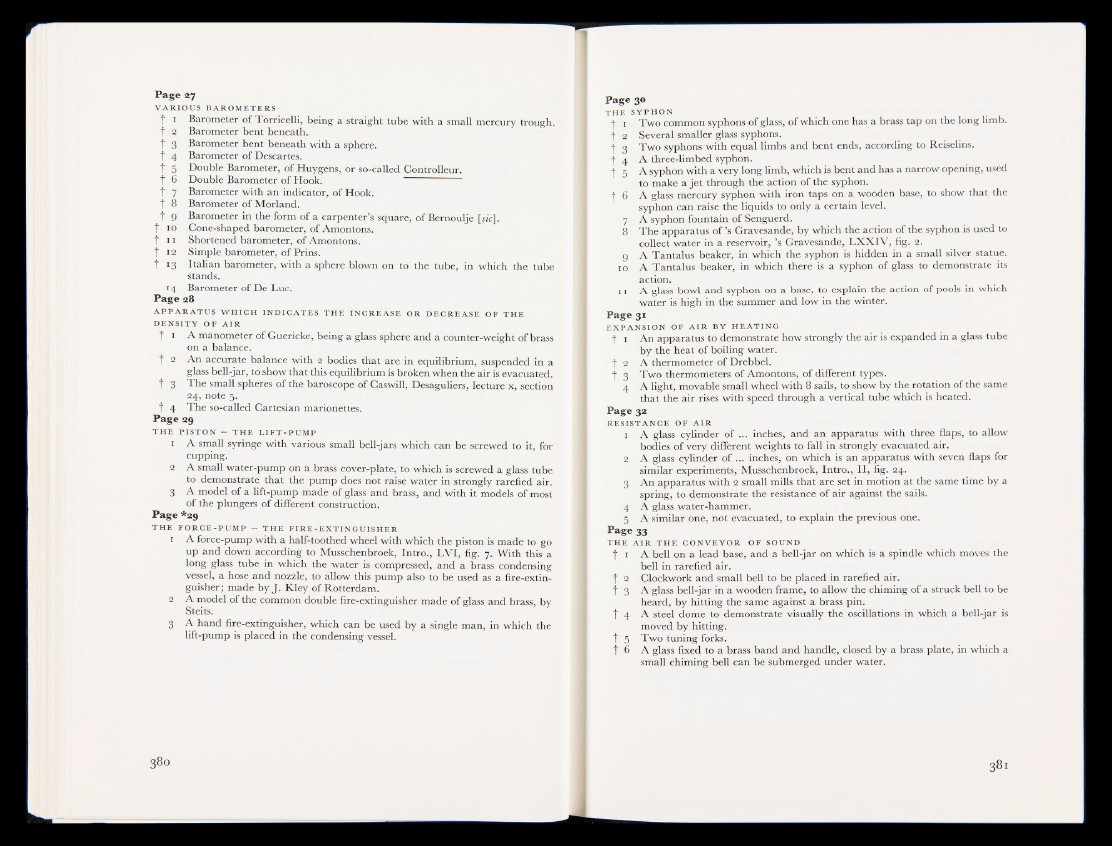
Page 27
VAR IO U S BAROMETERS
t i Barometer of Torricelli, being a straight tube with a small mercury trough.
t 2 Barometer bent beneath.
t 3 Barometer bent beneath with a sphere.
f 4 Barometer of Descartes.
f 5 Double Barometer, of Huygens, or so-called Controlleur.
f 6 Double Barometer of Hook.
t 7 Barometer with an indicator, of Hook.
t 8 Barometer of Morland.
t 9 Barometer in the form of a carpenter’s square, of Bernoulje [ffc].
t io Cone-shaped barometer, of Amontons.
f 11 Shortened barometer, of Amontons.
f 12 Simple barometer, of Prins.
t 13 Italian barometer, with a sphere blown on to the tube, in which the tube
stands.
14 Barometer of De Luc.
Page 28
A P P A R A TU S W H ICH IN D IC A T E S TH E IN CR EA S E OR D E C R EA S E OF TH E
D EN S IT Y OF A IR
t i A manometer of Guericke, being a glass sphere and a counter-weight of brass
on a balance.
f 2 An accurate balance with 2 bodies that are in equilibrium, suspended in a
glass bell-jar, to show that this equilibrium is broken when the air is evacuated.
| 3 The small spheres of the baroscope of Caswill, Desaguliers, lecture x, section
24, note 5.
t 4 The so-called Cartesian marionettes.
Page 29
TH E PISTON — TH E L IF T -P U M P
1 A small syringe with various small bell-jars which can be screwed to it, for
cupping.
2 A small water-pump on a brass cover-plate, to which is screwed a glass tube
to demonstrate that the pump does not raise water in strongly rarefied air.
3 A model of a lift-pump made of glass and brass, and with it models of most
of the plungers of different construction.
Page *29
TH E FO R C E -PUM P — TH E F IR E -E X T IN G U IS H E R
1 A force-pump with a half-toothed wheel with which the piston is made to go
up and down according to Musschenbroek, Intro., LVI, fig. 7. With this a
long glass tube in which the water is compressed, and a brass condensing
vessel, a hose and nozzle, to allow this pump also to be used as a fire-extinguisher;
made by J. Kley of Rotterdam.
2 A model of the common double fire-extinguisher made of glass and brass, by
Steits.
3 A hand fire-extinguisher, which can be used by a single man, in which the
lift-pump is placed in the condensing vessel.
Page 30
t h e s y p h o n
+ j Two common syphons of glass, of which one has a brass tap on the long limb.
+ 2 Several smaller glass syphons.
+ 3 Two syphons with equal limbs and bent ends, according to Reiselins.
j 4 A three-limbed syphon.
+ 5 A syphon with a very long limb, which is bent and has a narrow opening, used
to make a jet through the action of the syphon.
+ 6 A glass mercury syphon with iron taps on a wooden base, to show that the
syphon can raise the liquids to only a certain level.
7 A syphon fountain of Senguerd.
8 The apparatus o f ’s Gravesande, by which the action of the syphon is used to
collect water in a reservoir, ’s Gravesande, LXXIV, fig. 2.
9 A Tantalus beaker, in which the syphon is hidden in a small silver statue.
10 A Tantalus beaker, in which there is a syphon of glass to demonstrate its
action.
11 A glass bowl and syphon on a base, to explain the action of pools in which
water is high in the summer and low in the winter.
Page 31
e x p a n s io n o f a i r b y h e a t i n g
f i An apparatus to demonstrate how strongly the air is expanded in a glass tube
by the heat of boiling water.
| 2 A thermometer of Drebbel.
j 3 Two thermometers of Amontons, of different types.
4 A light, movable small wheel with 8 sails, to show by the rotation of the same
that the air rises with speed through a vertical tube which is heated.
Page 32
r e s i s t a n c e o f a i r
1 A glass cylinder of ... inches, and an apparatus with three flaps, to allow
bodies of very different weights to fall in strongly evacuated air.
2 A glass cylinder of ... inches, on which is an apparatus with seven flaps for
similar experiments, Musschenbroek, Intro., II, fig. 24.
3 An apparatus with 2 small mills that are set in motion at the same time by a
spring, to demonstrate the resistance of air against the sails.
4 A glass water-hammer.
5 A similar one, not evacuated, to explain the previous one.
Page 33
t h e a i r t h e c o n v e y o r o f s o u n d
t 1 A bell on a lead base, and a bell-jar on which is a spindle which moves the
bell in rarefied air.
t 2 Clockwork and small bell to be placed in rarefied air.
t 3 A glass bell-jar in a wooden frame, to allow the chiming of a struck bell to be
heard, by hitting the same against a brass pin.
t 4 A steel dome to demonstrate visually the oscillations in which a bell-jar is
moved by hitting.
t 5 Two tuning forks.
f 6 A glass fixed to a brass band and handle, closed by a brass plate, in which a
small chiming bell can be submerged under water.